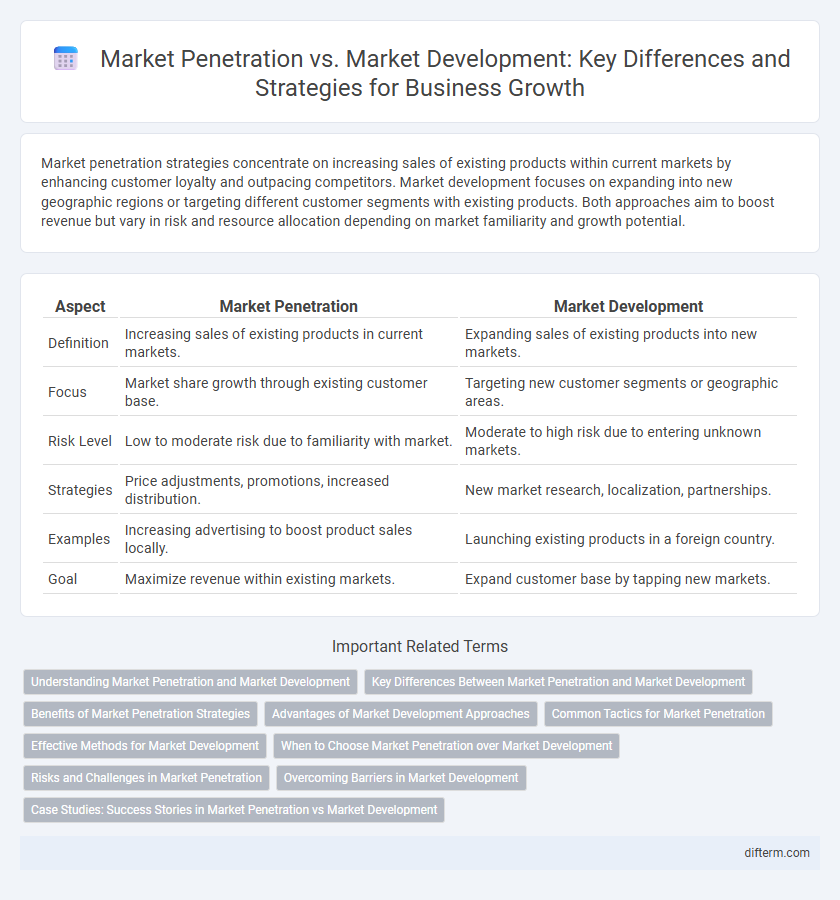Market penetration strategies concentrate on increasing sales of existing products within current markets by enhancing customer loyalty and outpacing competitors. Market development focuses on expanding into new geographic regions or targeting different customer segments with existing products. Both approaches aim to boost revenue but vary in risk and resource allocation depending on market familiarity and growth potential.
Table of Comparison
| Aspect | Market Penetration | Market Development |
|---|---|---|
| Definition | Increasing sales of existing products in current markets. | Expanding sales of existing products into new markets. |
| Focus | Market share growth through existing customer base. | Targeting new customer segments or geographic areas. |
| Risk Level | Low to moderate risk due to familiarity with market. | Moderate to high risk due to entering unknown markets. |
| Strategies | Price adjustments, promotions, increased distribution. | New market research, localization, partnerships. |
| Examples | Increasing advertising to boost product sales locally. | Launching existing products in a foreign country. |
| Goal | Maximize revenue within existing markets. | Expand customer base by tapping new markets. |
Understanding Market Penetration and Market Development
Market penetration focuses on increasing sales of existing products within current markets by capturing a larger customer base or boosting product usage among existing clients. Market development involves entering new markets or segments with existing products to expand the customer reach and revenue opportunities. Understanding the distinct strategies and objectives of market penetration and market development is essential for optimizing growth and allocating resources effectively.
Key Differences Between Market Penetration and Market Development
Market penetration focuses on increasing sales of existing products within current markets by enhancing marketing efforts, pricing strategies, or customer engagement to capture a larger market share. Market development involves expanding into new geographic regions or customer segments to introduce existing products, aiming to diversify revenue sources and reduce dependency on current markets. Key differences include market penetration targeting deeper growth within established markets, while market development pursues growth through exploring and entering new market territories.
Benefits of Market Penetration Strategies
Market penetration strategies boost sales by increasing the market share of existing products within current markets, driving immediate revenue growth and improving brand loyalty. These strategies reduce risks compared to market development since they focus on familiar customer segments and established distribution channels. Enhanced customer insights gained from deeper market penetration enable businesses to tailor marketing efforts and optimize product offerings effectively.
Advantages of Market Development Approaches
Market development strategies expand a company's reach by targeting new customer segments or geographical areas, increasing revenue potential without altering existing products. This approach reduces dependency on current markets, mitigating risks associated with market saturation or economic downturns. Market development also enhances brand recognition in untapped markets, creating long-term growth opportunities and competitive advantages.
Common Tactics for Market Penetration
Common tactics for market penetration in business include aggressive pricing strategies to attract price-sensitive customers, enhancing product quality or features to outperform competitors, and increasing promotional efforts through advertising and sales incentives. Companies may also expand distribution channels to improve product availability and leverage customer loyalty programs to boost repeat purchases. These approaches aim to increase market share within existing markets by intensifying customer engagement and maximizing product visibility.
Effective Methods for Market Development
Market development thrives on identifying and targeting untapped customer segments or geographic regions, leveraging data analytics and localized marketing strategies to tailor offerings. Strategic partnerships and adaptive product modifications enhance market receptivity and reduce entry barriers. Employing digital transformation tools like CRM systems and targeted advertising further accelerates customer acquisition in new markets.
When to Choose Market Penetration over Market Development
Market penetration is preferred when a company aims to increase its market share within existing markets by leveraging current products. This strategy is effective when market demand is underexploited, competitors are weak, or brand loyalty can be strengthened through pricing or promotional tactics. Choosing market penetration reduces risks compared to market development, which involves entering unfamiliar markets with new customer segments.
Risks and Challenges in Market Penetration
Market penetration involves increasing market share within existing markets, but it faces risks such as market saturation, intense competition, and price wars that can erode profit margins. Companies may struggle with customer loyalty and brand differentiation, making it difficult to capture incremental sales. Failure to innovate or misjudging consumer demand can also result in wasted resources and reduced market effectiveness.
Overcoming Barriers in Market Development
Overcoming barriers in market development requires strategic adaptation to local consumer behavior, regulatory environments, and competitive landscapes. Companies must invest in market research and local partnerships to navigate cultural differences and build brand trust. Effective barrier mitigation accelerates growth by enabling smoother entry and sustained presence in new geographic or demographic segments.
Case Studies: Success Stories in Market Penetration vs Market Development
Coca-Cola's market penetration strategy increased its share in existing beverage markets through aggressive marketing and distribution channels, leading to sustained revenue growth. In contrast, Starbucks' market development approach involved entering new international markets such as China, adapting its offerings to local tastes and preferences, resulting in rapid global expansion. These case studies demonstrate how targeted strategies in market penetration and development drive business growth by either deepening presence in current markets or exploring new customer segments.
Market Penetration vs Market Development Infographic

 difterm.com
difterm.com